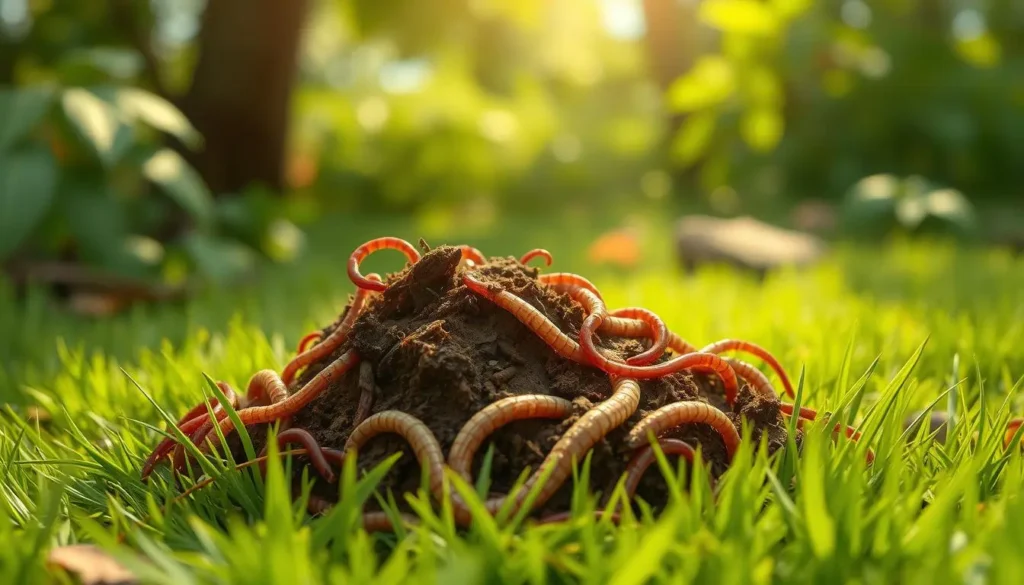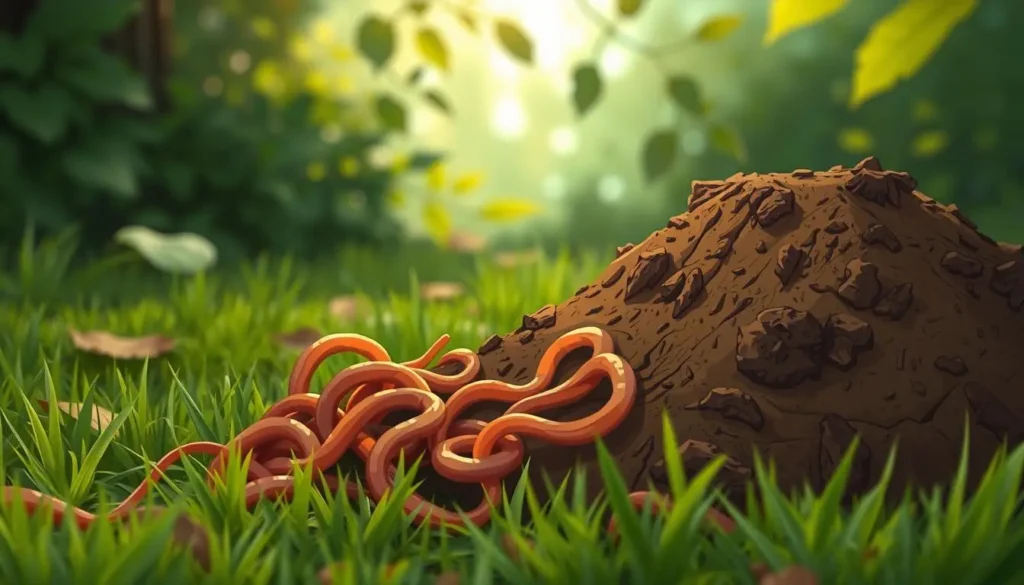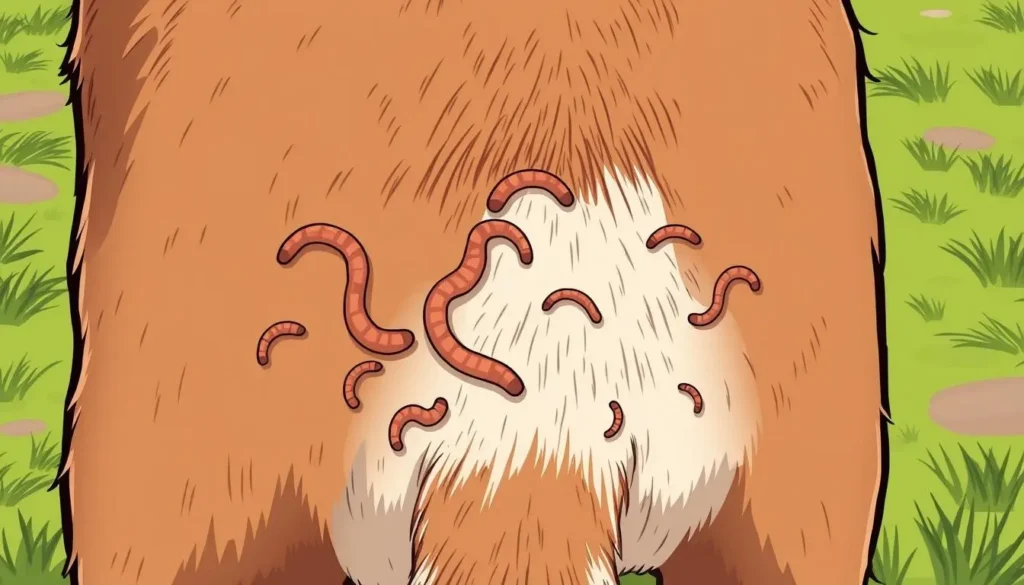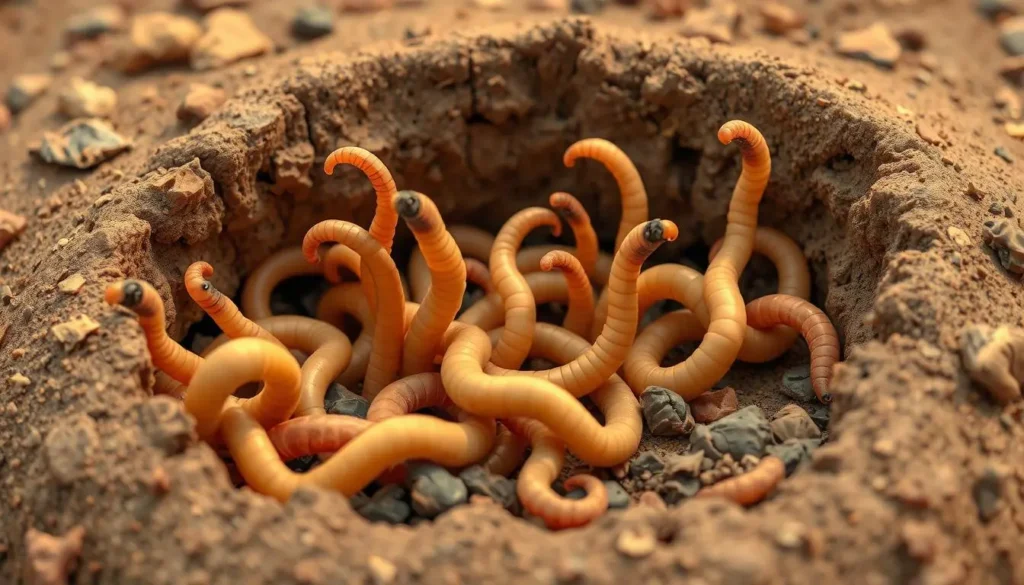Table of Contents
Worms in a dog’s poop can worry pet owners. These parasites can harm dogs if not treated. This article will tell you about the different worms, signs of infestation, and how to spot them. It also covers causes, diagnosis, treatment, prevention, and when to see a vet.

Key Takeaways
- Intestinal worms are common parasites that can infect dogs and be found in their poop.
- Understanding the different types of worms and their symptoms is important for proper diagnosis and treatment.
- Identifying worms in dog poop can help determine the type of infestation and guide veterinary care.
- Proper hygiene, regular deworming, and environmental control are crucial for preventing worm infestations in dogs.
- Seeking prompt veterinary attention is recommended if worms are suspected in a dog’s poop.
Understanding Worms in Dog Poop
Intestinal worms are parasites that live in a dog’s digestive system. They can make dogs sick if not treated. Knowing about the common worms in dogs helps keep them healthy.
What are Intestinal Worms?
Intestinal worms are parasites that reside in a dog’s digestive system. They eat the nutrients from the dog’s food. This can make the dog sick. The worms lay eggs or larvae that can spread through the dog’s poop.
Common Types of Worms in Dogs
- Roundworms – These are the most common worms in dogs. Roundworms can grow up to several inches long. They can cause digestive problems, poor growth, and even blockages in the intestines.
- Hookworms – Hookworms attach to the intestines and feed on the dog’s blood. This can lead to anemia and weight loss.
- Tapeworms are elongated, flat parasites that can reach several feet in length. They are often caught by eating infected fleas or prey.
- Whipworms – Whipworms are thin, thread-like worms that burrow into the large intestine. They cause inflammation and diarrhea.
Knowing about the different worms that can infect dogs is key for treatment and prevention. By understanding the common worms in dogs and their symptoms, pet owners can work with their vet to keep their dogs healthy.

Signs and Symptoms of Worm Infestation
It’s important to know the signs of worms in dogs to get them treated quickly. Dog owners should watch for signs that their dog might have worms.
Diarrhea is a common sign of worms in dogs. They may have loose, watery stools with a bad smell. Vomiting can also happen because worms can upset their stomach. If a dog is losing weight but still hungry, it could mean they have worms.
A dog’s coat can also show if they have worms. If their coat looks dull, dry, or patchy, it might mean they’re not getting the nutrients they need.
- Diarrhea
- Vomiting
- Weight loss
- Poor coat condition
Sometimes, you can see worms or their parts in a dog’s stool. These can look like small, white rice or long, spaghetti-like things, depending on the worm type.
| Symptom | Description |
|---|---|
| Diarrhea | Loose, watery stools with a foul odor |
| Vomiting | Caused by the irritation of worms in the digestive system |
| Weight loss | Unexplained weight loss despite a healthy appetite |
| Poor coat condition | Dull, dry, or patchy coat indicating poor nutrient absorption |
| Visible worms | Small, white, rice-like segments or larger, spaghetti-like organisms in the stool |
Spotting the signs of worms in dogs is the first step to help them. If you think your dog has worms, see your vet right away. They can diagnose and treat the problem.

Worms in Dog Poop: Identification
Spotting worms in your dog’s poop is key to fighting off parasites. You’ll see everything from roundworms to tapeworms. Knowing what these worms look like helps keep your dog healthy.
What Do Worms Look Like in Dog Poop?
Worms in dog poop come in different sizes, shapes, and colors. Roundworms look like long, white spaghetti. Hookworms are smaller and have a hook shape. Tapeworms look like small, white rice grains.
Pictures of Worms in Dog Poop
Here are some pictures of worms in dog poop to help you recognize them:

| Worm Type | Appearance in Dog Poop |
|---|---|
| Roundworms | Long, spaghetti-like, white or pale in color |
| Hookworms | Smaller, thinner, with a hooked appearance |
| Tapeworms | Small, white, flat segments resembling grains of rice |
Knowing what worms look like helps you spot problems early. This ensures your dog stays healthy and happy.
Causes and Risk Factors
Understanding worms in dog poop is key. Dogs can get worms from contaminated soil or by eating infected animals. Pet owners need to know these causes and risk factors.
How Dogs Get Worms
Dogs can get worms in many ways. One common way is by eating contaminated soil or feces. This happens when they explore or look for food.
Another way is through eating infected prey like rodents or birds. Dogs that go to public parks or doggy daycares are at higher risk. Poor hygiene and not deworming regularly also play a part.
Warm and humid climates are perfect for some worms. This makes dogs in these areas more likely to get infected.
| Common Causes of Worms in Dogs | Potential Risk Factors |
|---|---|
| Ingesting contaminated soil or feces Consuming infected prey (rodents, birds) Exposure to the feces of other infected dogs | Poor hygiene and sanitation Lack of regular deworming Warm and humid climate conditions Frequent interaction with other dogs (parks, daycares) |
Knowing how dogs get worms helps protect them. Pet owners can keep their dogs healthy and happy by understanding these risks.
Diagnosing Worm Infestations
Finding worms in a dog’s stomach is key to treating them. Vets use diagnosing worms in dogs through fecal examinations and blood tests. This helps them figure out the best treatment.
Fecal Examination
The main way to check for worms is by looking at the dog’s stool under a microscope. This test, called a fecal flotation test, spots worm eggs or larvae. It tells the vet what kind of worm is there, helping to target the treatment.
Blood Tests
Blood tests for worms in dogs are also important. They find antibodies or proteins made by the dog’s immune system against worms. Blood tests can also show changes in blood cells that suggest worms.
| Diagnostic Test | Purpose | Advantages |
|---|---|---|
| Fecal Examination | Detects the presence of worm eggs or larvae | Identifies the specific type of worm Provides direct evidence of infestation |
| Blood Tests | Detects antibodies or changes in blood cells | Helps confirm the diagnosis Useful for certain worm species that are difficult to detect in fecal samples |
Vets use fecal exams and blood tests together. This way, they can accurately diagnose worms in dogs. Then, they can make a good plan to treat the worms.
Treatment Options for Worms in Dogs
Keeping your dog healthy means treating worms in dogs. There are many ways to get rid of these parasites. The most common method is using deworming medications. You can buy these over-the-counter or get a prescription.
Over-the-Counter Deworming Medications
For mild cases, over-the-counter dewormers are a good choice. They contain ingredients like pyrantel pamoate and fenbendazole. These help get rid of worms from your dog’s system. Always read the instructions and talk to your vet before giving these to your dog.
Prescription Deworming Medications
For serious cases, your vet might prescribe stronger meds. These include fenbendazole and ivermectin. They are more effective against many types of worms. Your veterinarian will select the most suitable option for your dog.
It’s key to follow the treatment plan and finish it. Your vet might also want to check your dog’s stool to make sure the worms are gone. This helps ensure your dog is fully dewormed.
| Medication | Active Ingredient | Availability | Effectiveness |
|---|---|---|---|
| Pyrantel Pamoate | Pyrantel Pamoate | Over-the-Counter | Moderately Effective |
| Fenbendazole | Fenbendazole | Prescription | Highly Effective |
| Ivermectin | Ivermectin | Prescription | Highly Effective |
| Milbemycin Oxime | Milbemycin Oxime | Prescription | Highly Effective |
Knowing your options and talking to your vet can help treat worms in dogs. This keeps your dog healthy and happy.
Deworming Medications and Dosages
Dogs can get worms, and pet owners have many ways to fight them. There are over-the-counter and prescription deworming medicines. Each has its own ingredients, dosages, and ways to use them. Knowing about these options helps dog owners choose the best treatment for worms.
Over-the-Counter Deworming Products
Many over-the-counter deworming products for dogs are out there. They often have ingredients like pyrantel pamoate, fenbendazole, or praziquantel. These are easy to give to dogs, in forms like chewable tablets, liquids, or topical treatments. It’s crucial to follow the dosage guidelines according to your dog’s weight.
Prescription Deworming Medications
For serious worm problems, vets might prescribe stronger medicines. These include ingredients like milbemycin oxime, selamectin, or moxidectin. They can be given orally, topically, or by injection. Always get these medicines from a vet, as they need to be used carefully.
It’s key to talk to a vet about deworming medicines for your dog. They can tell you the best treatment, how much to give, and how often. This helps get rid of worms and stops them from coming back.
| Deworming Medication | Active Ingredient | Administration | Dosage |
|---|---|---|---|
| Pyrantel Pamoate | Pyrantel pamoate | Chewable tablet, liquid | 5-10 mg/lb body weight |
| Fenbendazole | Fenbendazole | Granules, paste | 50 mg/kg body weight |
| Praziquantel | Praziquantel | Tablet, topical | 5-10 mg/kg body weight |
| Milbemycin Oxime | Milbemycin oxime | Tablet, chewable | 0.5-2 mg/kg body weight |
| Selamectin | Selamectin | Topical | 6-12 mg/kg body weight |
| Moxidectin | Moxidectin | Oral, injectable | 0.1-0.2 mg/kg body weight |
Always talk to a vet to find the right deworming medicine and dosage for your dog.
worms in dog poop
Understanding worms in dog poop is key. Worms in dog poop come in different shapes and sizes. Knowing what they look like can help identify the worm type in your dog.
Roundworms are common in dog poop. They look like long, thin spaghetti noodles. Their color can vary from white to tan or even brownish-red. What do worms look like in dog poop? Roundworms might be seen as they leave the dog’s body.
- Tapeworms are flat and segmented, ranging from a few inches to several feet long.
- Hookworms are small and thin, with a hook shape that helps them stick to the dog’s intestines.
- Whipworms are thin and thread-like, making them hard to spot in dog feces.
Knowing what worms look like in dog poop helps pet owners take action. They can seek vet help and prevent worms. Regular deworming and good hygiene are key to keeping dogs worm-free.
“Identifying the type of worm in your dog’s poop is the first step in effectively treating the infestation and preventing further complications.”
Being aware of worm types and their looks helps keep dogs healthy. Pet owners can take steps to protect their dogs’ health.
Prevention and Management Strategies
Keeping dogs worm-free is key for pet owners. A mix of good hygiene, controlling the environment, and regular deworming helps protect your dog. This way, you can keep your dog safe from worms.
Hygiene and Environmental Control
Good hygiene stops worms from spreading. Cleaning up your dog’s waste and keeping their living area clean is important. Also, make sure their space is not damp or shaded. This makes it hard for worms to live there.
Regular Deworming Schedule
Sticking to a deworming plan is vital. Your vet will tell you how often to deworm your dog. This depends on their age, lifestyle, and risk of getting worms. Deworming regularly helps get rid of worms and stops new ones from coming.
| Deworming Schedule for Dogs | Frequency |
|---|---|
| Puppies | Every 2-4 weeks until 12 weeks old, then monthly until 6 months old |
| Adult Dogs | Every 3-6 months, or as recommended by your veterinarian |
| Dogs at High Risk | Monthly or as directed by your vet |
Good hygiene and regular deworming keep dogs healthy. This way, you can prevent worms and keep your dog happy and healthy.
Complications and Potential Risks
Worms in dogs can cause serious health problems and even spread to humans. It’s important for pet owners to know about these risks. This way, they can get their pets the care they need quickly.
Worms can harm a dog’s health in many ways. They can make the dog malnourished, leading to weight loss and a weak immune system. In bad cases, worms can block the intestines, which is very dangerous.
Some worms, like roundworms and hookworms, can also affect humans. This is a big worry for families with young kids. These worms can cause serious infections in people, affecting the intestines and skin.
| Complication | Description |
|---|---|
| Malnutrition | Worms compete with the dog for essential nutrients, leading to weight loss, poor coat condition, and a weakened immune system. |
| Intestinal Obstruction | In severe cases, worms can obstruct the intestines, causing life-threatening complications. |
| Zoonotic Transmission | Certain worms, like roundworms and hookworms, can be transmitted from dogs to humans, posing a health risk, especially for children. |
To avoid the risks of worms in dogs and their complications, pet owners must team up with their vets. Regular deworming, keeping things clean, and treating worms fast are key. This helps keep both the dog and the family healthy.
When to See a Veterinarian
As a responsible pet owner, knowing when to take your dog to the vet for worms is key. Spotting these signs early can stop problems and keep your dog healthy.
Seeing worms or worm parts in your dog’s stool is a clear sign. If you find anything odd in their poop, see the vet fast. Other signs include ongoing digestive issues like diarrhea, vomiting, or a lack of appetite.
Also, if your dog seems tired, loses weight, or has a dull coat, worms might be the cause. Keep an eye on your dog’s health and act quickly if you notice any changes.
Regular deworming and good hygiene can help prevent worms. But, if you think your dog has worms, always check with your vet. They can test, find out what kind of worm, and treat your dog right.
“Seeking prompt veterinary attention is crucial when it comes to addressing worm infestations in dogs. Early detection and proper treatment can make all the difference in your pet’s health and comfort.”
When it comes to your dog’s health, it’s always better to be safe than sorry. If you’re worried about when to take dog to vet for worms or signs to see vet for worms in dogs, don’t wait to call your vet.
| Symptoms | Potential Worm Infestation |
|---|---|
| Visible worms or worm segments in stool | Yes |
| Ongoing digestive issues (diarrhea, vomiting, poor appetite) | Yes |
| Lethargy, weight loss, or dull coat | Yes |
| No visible signs, but concerns about worms | Yes, consult with a veterinarian |
Conclusion
Worms in a dog’s poop are common and can be treated. Knowing the different types of worms and their signs is key. Regular deworming and keeping things clean help prevent worms.
The key takeaways on worms in dog poop are: regular vet visits and fecal exams. Follow a deworming schedule and keep your home clean. If you see signs of worms, act fast.
The worms in dog poop summary is that worms are manageable with the right care. Knowing the causes, symptoms, and treatments helps protect pets. This keeps homes free from parasites.
FAQ
What are the common types of worms found in dog poop?
Dogs can get several types of worms from their poop. These include roundworms, hookworms, tapeworms, and whipworms. If not treated, these worms can make dogs very sick.
What do worms look like in dog poop?
Worms in dog poop look different based on their type. Roundworms are long and look like spaghetti. Tapeworms are small and white, like rice.
Hookworms and whipworms are harder to see without a magnifying glass.
What are the signs and symptoms of a worm infestation in dogs?
Dogs with worms might have diarrhea or vomit a lot. They could also lose weight or have a bad coat. You might see worms in their poop.
They might feel tired, have belly pain, or not want to eat.
How do dogs get worms?
Dogs get worms in many ways. They can pick them up from dirty places, eating other animals, or from other dogs’ poop. Puppies can even get worms from their mom before they’re born.
How are worm infestations in dogs diagnosed?
Vets use a special test to find worms in dogs. They look at the dog’s poop under a microscope. They might also take blood to check for worms.
What are the treatment options for worms in dogs?
Vets give dogs medicine to get rid of worms. This can be over-the-counter or prescription. The type of medicine depends on the worms and how bad the infestation is.
How can I prevent worms in my dog?
Keeping your dog’s area clean helps prevent worms. Always clean up after your dog and throw away their poop. Also, make sure your dog gets deworming medicine as recommended by your vet.
When should I take my dog to the vet for worms?
If you see worms in your dog’s poop or they’re not feeling well, take them to the vet. This is especially true if they have ongoing stomach problems or other symptoms.